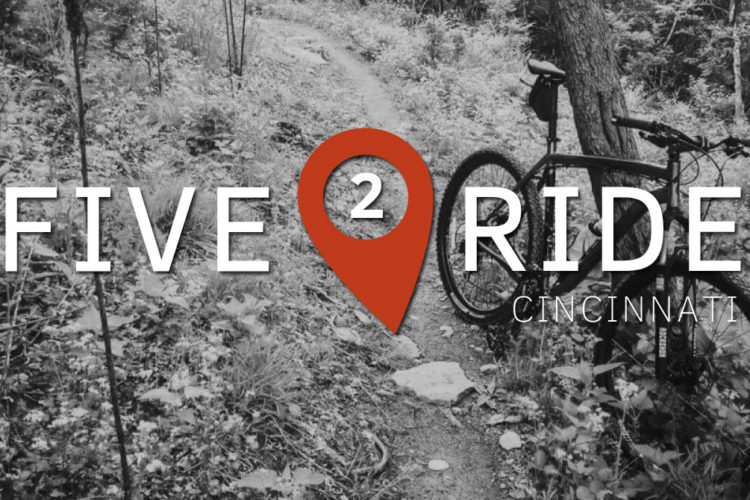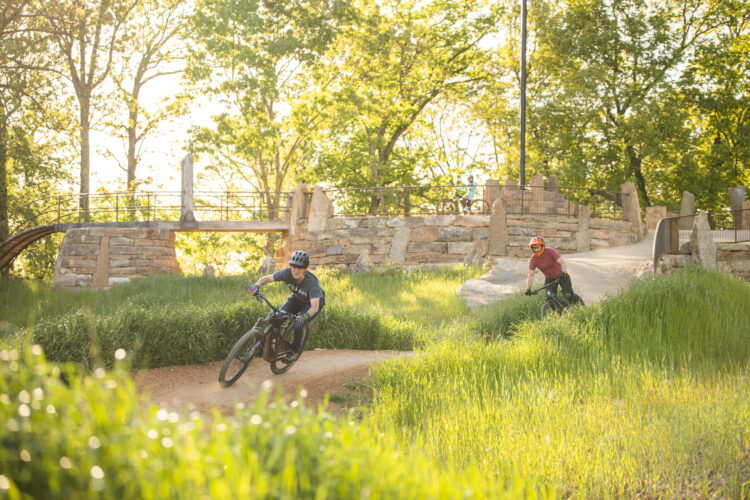
When we think of “mountain bike towns,” our first thoughts are typically of small towns, off the beaten path, tucked away in the mountains. However, this image is being challenged as more trails are built in major metropolitan areas.
As we chatted with the mountain bike advocates building trails in Cincinnati’s neighborhoods, we found that their aspirations are much higher than just scratching in a trail here and there. While mountain bike trails aren’t entirely new to Cincinnati, a Bentonville-style network of connected trail hubs is.
And that is precisely what’s in the works for the larger Cincinnati metropolitan area.

A new trail at Avoca Trailhead
Just east of downtown Cincinnati, the Little Miami River forms the majority of Anderson Township’s northern border. On the far side of the Little Miami is Avoca Park and the Avoca Trailhead, which will be home to some new trails.
The trail building process began in 2018 when Great Parks, a county park system for Hamilton County, began putting together a comprehensive master plan for the county’s parks. As the plan was developed, Great Parks asked county residents what they wanted out of their parks. One of the overwhelming responses was “new trails.”
“Adding trail expansions and connections is the number one priority the public established for Great Parks, and we’re excited to start building the first piece of this new network,” Great Parks CEO Todd Palmeter said in a statement released by the organization.
Following the initial feedback, Great Parks began developing detailed plans to incorporate trails into specific parks, starting with a trail at Avoca Park along the Little Miami River.
“This particular section will be about a mile and a half,” Jessica Spencer, Director of Natural Resources for Great Parks, told us. “It’ll be open to [hikers], bikers, adaptive mountain bikers, and also trail runners.”
Trail work at Avoca Trailhead began in early September. Spencer shared that she thought the trail would be completed in the next month or so, but the speed at which they progress depends on the weather. As of now, trail builders need moisture.
Great Parks is taking the lead on building the trails. Spencer shared that the county has two trail specialists doing most of the labor. Since funding comes from taxpayer dollars, Great Parks hopes that not having to contract out the trail building labor will save some money. Spencer shared that they’ve had trail builders — be that full or part-time — on staff for the last decade.
Along with building trails, Great Parks also takes the lead on maintaining trails. With over 18,000 acres of parks across Hamilton County, it is undoubtedly a tremendous task. Spencer shared that along with a dedicated trail building crew, a larger staff team is tasked with park and trail maintenance. “It’s a game changer when you’ve got dedicated staff doing this day in and day out,” she told us.
Even though Great Parks has a large crew focused on the trails, others still play a crucial role. Spencer pointed to organizations like the Cincinnati Off-Road Alliance (CORA) as a vital part of the trails being built, as well as the networks the organization hopes to establish.

A Bentonville-inspired network of trails
Bentonville, Arkansas, boasts a “trails from your doorstep” mentality. People visiting Bentonville talk about how one of the best things about their stay was riding to the trails from their rental house and how one trail system connects to the next. Places like the greater Cincinnati metro area are catching on and planning similar trail systems.
“We’re pushing ahead with the concept around community building and community benefits,” Jason Reser, the Trail Development Director for CORA told us. “Making [trails] accessible near to where people live versus what our traditional trail systems are.”
The new mile-and-a-half trail at Avoca Trailhead is just the first in a network of trails in more urban-focused areas. In fact, Great Parks is planning ten miles of new trails in the area, some of which will connect to other trail systems.
Reser explained that the plan is to blur the line between where one trail system ends and the other begins. This makes sense when building trails in urban environments where park space is pretty limited and the trails are relatively short.
“No one’s going to drive to Avoca for a one-mile experience,” Reser told us. “[But] what this does is it starts to link [trail systems] up.” The limited space at Avoca Trailhead won’t seem so limited because it will be connected to places like Terrell Park Trailhead, which is just three miles away on the bike path.
Reser is excited about the opportunity to connect neighborhoods and townships in the greater Cincinnati area through trail networks. In addition, he also believes the area offers good terrain for building some incredible trails.
A common misconception about Ohio is that the state is mostly flat. While Reser didn’t necessarily dispute that sentiment, he offered a different perspective by referencing the Appalachian Mountains of Kentucky. Geography buffs know that Cincinnati sits just across the Ohio River from Kentucky’s rolling hills.
“We have […] beautiful wooded hillsides [and] we’re really hoping to start linking those up,” Reser told us. “There are river valleys that have been more or less preserved because they get flooded. And so we’re looking at those types of opportunities and really becoming a trail city.”
These river valleys are being preserved from housing development because of the threat of floods. However, Reser thinks they offer incredible potential for mountain bike trail opportunities, so long as the trails stay above the water.
While CORA anticipates planning and building some quality mountain bike trails in the next few years, they certainly don’t forget the diverse community they serve in Cincinnati.
“That’s our mission and vision,” Reser said, “to get more trails where people are and make that impact; do real community building with trails.”





















1 Comments
Oct 15, 2024